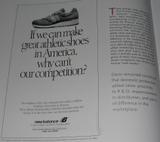

Here's a couple of page selections from the centennial book by New Balance. Its amazing how far the brand has come. Today, NB is the only major footwear manufacturer in the world that remains privately held. This independence allows for long term decisions rather than bottom-line view of shareholders. It is also this reason that allows for such prolonged domestic manufacturing as well as the sustained manufacturing design of multiple widths footwear.

And to think it all started from a chicken's foot that inspired the invention of the New Balance Arch by William J Riley.


Riley subsequently developed the first NB running shoe and manufacturing custom-made shoes for baseball, basketball, tennis and boxing as well. When Eleanor and Paul Kidd took over, it heralded a new era, defined by the introduction of the Trackster in 1960, the first performance running shoe made in multiple widths and featured a ripple outsole to enhance traction, absorb shock and prevent injuries common to spikes common in the day.
Even then, New Balance offered no incentives to the atheletes, trainers and coaches who promoted the shoe. The popularity of NB footwear in sports instituitions and performance arenas only proves to show the true quality of a properly fitted and designed shoe.
After a disastrous flood that threatened to wipe out the small company, NB entered the modern age under Jim Davis. Paul Kidd offered the new owner one important advice "keep the widths". Davis brought along a breath of fresh air the brand needed as well as a certain Terry Heckler who did the branding for K2, the ski company.
Heckler wanted shoes that had the performance look and feel that runners could relate to.

"Ma and Pa Balance"
Heckler also brought along his quirky sense of humor, as shown by the ads for the NB 320.
Not only that, Heckler's other key contribution was the numbering system for shoes that still runs true to this day. He felt that NB wouldbe better off keeping focus on the brand rather than on any particular shoe. Naming shoes created "stars". The numbering system gave equal status to each shoe and reinforced the public's perception of NB as a performance brand.
The model 320 not only clinched #1 in Runner's World magazine, it also brought unprecedented sales and profits to the company. Ensuing expansion in manufacturing and production bucked the industry trends of moving manufacturing processes overseas. Thus gave rise to the "Made in USA" policy


The FTC [Federal Trade Commision] even tried to debunk NB's proclamation by saying it wasn't 100% "made in USA". Of course, would the American public [or for the matter, anyone else] would've thought that the leather from the 587 come from a cow grazing in Brazil or Wyoming? Thus the case was dropped when independent studies showed that as long as at least 70% of the labor and materials are American, that label is watertight.

Ad for NB 620, one of the lightest shoe in the market at the time, hails the R&D advancement of the company. It was also the first shoe to break the $50 barrier.

Yet another innovative ad, hinting at the political balance during the time and the focus on stability cushioning of the 675. This fab shoe was recently re-released as part of the Filmby Heroes pack

The Rainier, NB's first hiking boot, accompanied Lou Whittaker with the first American team to ascent Mt Everest's North Wall in 1982

A familiar box from 1990 with the innovative folding shoe box and integrated lid, printed with the company's new tag line.
A small mention of Singapore and how the local subsidiary became the sole supplier to every military recruit in the country.

"Achieve New Balance" focus for the millenium and beyond
Striving for a closely-knit company has always been an NB trademark.

A treasured keepsake from the NB fam. All the best for the next century! Stay true!
No comments:
Post a Comment